Just a simple Bead!
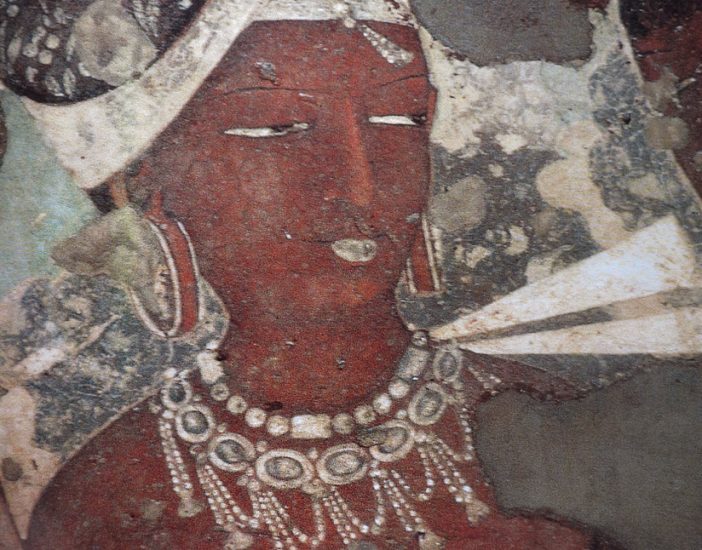
In a time long before ours, about 100,000 years ago, a period which leaves us no written records, we have at our hands, a variety of artifacts that our ancestors left behind for us…. And like pieces of a puzzle, these objects come together to narrate the story of our shared past. One of the many mute objects left behind by our prehistoric family for us to marvel over are beads and the story of these tiny circular artifacts begins from the seas, teeming with life. Our prehistoric ancestors from the region of Skhul in Israel, journeyed for many miles to reach the sea. The purpose of this journey was to collect diverse items, essential for them. One of the things that inspired their inquisitiveness were the shells of snails residing in the seas they stumbled upon.
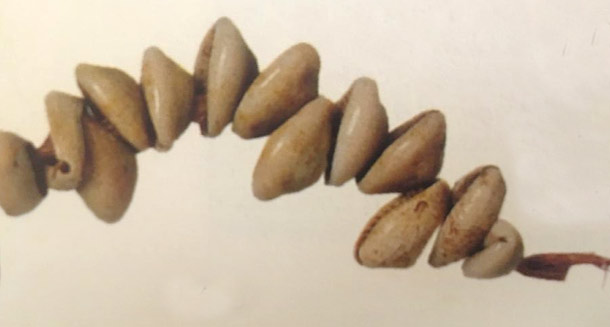
As they procured these shells and travelled back to their homes with other finds, they began to experiment with their tools to create an exciting innovation. Little did they know that what they were about to create with these shells was going to play a monumental role in the collective history of humanity, for years and years to come. With great precision and care, these marine shells were perforated with the intention of creating an ornament. Whatever may be the purpose behind giving birth to this innovation, as our ancestors created holes in these sea shells, they gave existence to the world’s oldest known jewellery; beads.
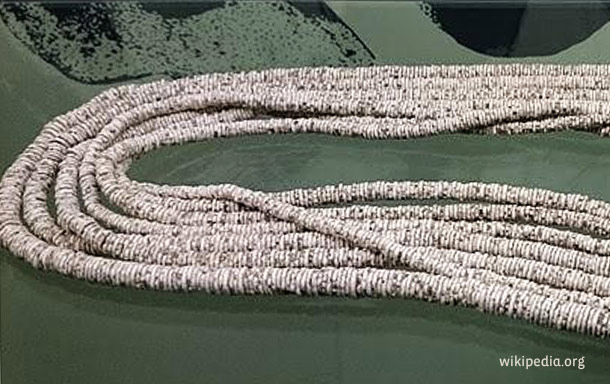
As the prehistoric humans slowly understood the drama of nature which unfolded before their eyes, they began to engage with it through their creative innovations. They created necklaces, armlets, girdles, anklets and bracelets made out of the beads of sea shells or the eggshells of ostriches. And as they kept experimenting with different materials, the influence of these ornaments kept getting stronger. So strong was the impact that beads travelled thousands of years to continue their legacy in the first grand civilizations of our ancient past. Sought after everywhere, beads began to play a defining role in the society. Be it in the ancient Egyptian lands under the patronage of the Pharaohs, or the land between the two rivers; home to the Mesopotamian Civilisation, or the ancient civilisation of the Indus Valley, which flourished in areas of present-day India, Pakistan and Afghanistan.

As early as 5000 years ago, beads became crucial in forging political, social and cultural linkages between the civilisations of the ancient world, through trade. From the mines of Shortugai and Badakshan in Afghanistan, was born the deep-blue semiprecious stone prized for its intense colour, lapis lazuli. Mined in Afghanistan, beads made out of this semiprecious stone were highly valued in the ancient civilisations and thus, products of lapis were exported to the lands of Egypt, Mesopotamia and Indus Valley. Once transported, it was utilised to create ornaments of many kinds; the Egyptians used the blue beads to decorate expensive finger-rings and head ornaments, the Mesopotamians created long necklaces fused with lapis and gold and the Harappans made glamourous armlets and bracelets out of it.
If lapis was loved for its intense shade of azure, carnelian was prized for its captivating red colour. When the demand for carnelian in Mesopotamia rose, the exporters at Harappa & Lothal, where it was procured were notified. Large quantities of carnelian beads were sent to the areas of present-day Iraq and Syria, only for necklaces of these red beads; to be buried in the royal Sumerian tombs. Some of these carnelian beads made their way to Egypt as well and along with these red beads, the Egyptians used faience, feldspar and turquoise in their beadmaking workshops. Creative Egyptian minds bestowed their artistic touch upon these beads and shaped them in the form of comical faces and expressive animal heads!
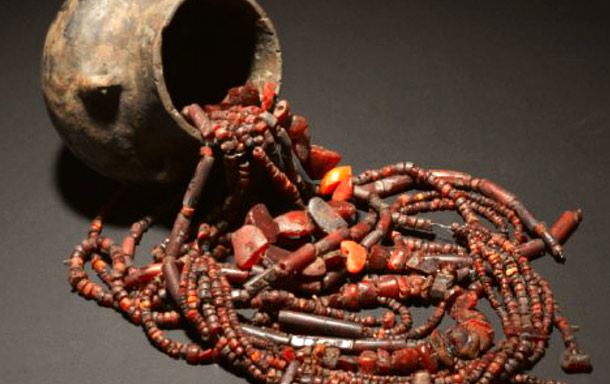
Similar to how Carnelian and Lapis were exported from the Indus, an extensive trade network of blue glass-beads ran from Egypt in about 14th century BCE. For Egyptians, the inventors of glass-beads, their invention was precious because it entailed a lot of labour and know how and could only be afforded by the elite. In their workshops, a vibrant scene unfolded as many workers engaged themselves in manufacturing luxurious cobalt glass-beads. From workshops, they were sent directly to the families of the elite to entice them or were exported to far-off regions in the North, such as Denmark. If the glass beads of Egypt travelled to the North, beads made of amber used the same route and came from the North to reach the most distant parts of the Mediterranean.

This connection based on the exchange of beads of amber and blue glass was not only economically but symbolically significant. Amber represented the Sun God and blue glass-beads of Egypt signified the heavens, life and rebirth. Therefore, selected beliefs and stories travelled along these trade routes. This trade route vibrantly flourished till about 1200 BCE and collapsed thereafter due to war, strife and political instability. Both trade and stories were lost. Incidentally, around the same time, the glass-bead making industry in India was blossoming in several regions; from Kausambi in northern India, all the way to Arikamedu in the south.
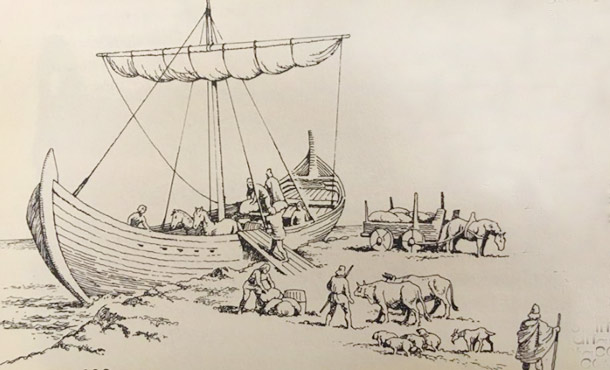
The craftsmen of Northern India carefully manufactured glass-beads which imitated beads made of stones such as agate, onyx and carnelian. In the towns of Tamil Nadu and Pondicherry, the talented glass workers engaged in sophisticated processes to create glass beads. By 1000 BCE, Arikamedu was already an acknowledged site for glass-bead making. Beads were made using the drawn glass process, later adopted by European glass makers. About 100 pounds of molten glass was drawn into a cane (a thin hollow tube) and then cut into pieces and tumbled. These were the first seed beads; 3-5 mm in size, created in diverse colours; black, yellow, opaque, ‘Indian’ red, green, violet, translucent blue and many more. This range of colours displays extraordinary and sophisticated glass making skills. Through trade, these finished glass beads were exported overseas, and travelled to Indonesia, Africa, China, Korea and Japan.
By 300 BCE, glass-beads were no longer exclusive to certain parts of India but were found almost everywhere. One can imagine the women of ancient India, adorning kacha (glass) beads with an alluring gold thread! Or a King ordering for glass beads to be imported to his region to decorate horses for the Ashvamedha (horse) Yagna.
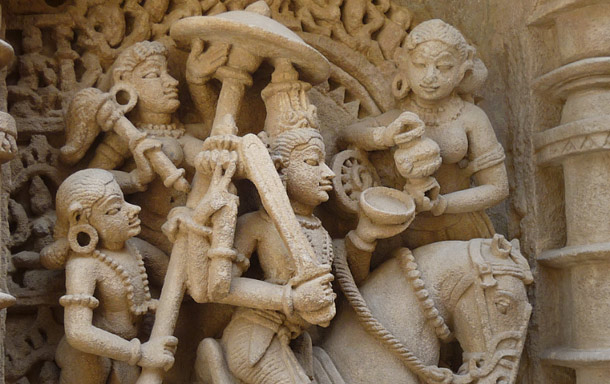
Excavations in Arikamedu, Tamil Nadu reveal Roman beads, coins and glassware; implying ancient trade links between southern India and Rome between 200 BCE – 700 CE. However, there are also evidences of a flourishing glass-bead making industry in India since 1000 BCE; suggesting that the craft flourished in India independently. Though it is possible that it was only when the Roman Empire had conquered Egypt in the 100 BCE that they learnt the craft. The Romans enhanced the methods involved in the craft and revolutionised the industry. Huge ovens were built like never before and glass blowing pipes were introduced. These interventions along with extensive trade helped spread large quantities of glass and glass-beads cost effectively to many places. Millefiori, a sophisticated colourful glass making technique was used not only to make beads but tableware pieces, glass windows, mosaic tiles for baths, floors, fountains and walls. These beautiful Millefiori beads were used to trade far and wide including places like central Africa, China and Scandinavia.
However, the fate of the glass-bead-making industry in the Roman world was such that by 400 CE, it absolutely collapsed. As Europe got Christianized, disapproval of vanity became the norm and adornment of jewellery was looked down upon.The craft of bead making in Europe started to cease and was restricted to small productions of rosary beads for religious purposes. But who can stifle creativity from flourishing? In 1100 CE, Venice grew stronger as a republic and its exemplary commercial success led to the revival of the craft and the legacy of glass-beads continued.
Soon Venetian Republic began to fear the destruction of the wooden buildings of the city because of the fire used in the craft, all the glassmakers from Venice were moved to Murano island in the late 1200 CE. Discovery of Lamp working method of bead making in 16th century made it possible for women to work from their homes to make beads. This increased the overall productivity. In the subsequent centuries, exports from this island flourished and the island became extremely popular for its fine glass beads. The glass makers held a monopoly on high-quality glassmaking and refined technologies such as enameled glass (smalto), optically clear glass and milk glass (lattimo). When Marietta Barovier of the Murano glassmaking family invented the Rosetta beads in 1480 CE, these multicolored glass beads became vital in the realm of trade. Christopher Columbus is said to have traveled with them for privileges such as secure passages through dangerous waters.

If the glass makers of Venice had established their monopoly on Rosetta beads, the glass-workers of Bohemia, in present-day Czech Republic, were well reputed for their Bohemian crystals. By 1500-1600 CE, the crystals of Bohemia gained popularity for their excellent cut and engraving. The glassmaking industry of Bohemia flourished and by the 19th century, they were mass-producing coloured glass which was being exported all over the world. In 1895, Daniel Swarovski invented a machine which could cut and polish crystal – an invention which revolutionised crystal manufacturing and helped in establishing the crystal bead making firm, Swarovski.

Another event in the 19th century was taking place in Japan when Japanese glassmakers had started creating blown beads and inaugurated their own glass industry. Japanese seed companies – Matsuno, Miyuki and Toho beads – were established by the 20th century, and since then, Japanese seed bead industries have mastered creating extraordinary beads. This was also the period when the first man-made pearls came into existence! For centuries, people had forayed to the very depths of the seas in search of natural pearls, which are found from oyster shells. It was only in the 19th century CE when a Japanese entrepreneur, Mikimoto Kokichi, created the first cultured pearl by manually introducing irritants inside an oyster!
If glass-beads are prized for their beauty, versatility and durability, beads of pearl are a symbol of purity and protection. The precious gemstone is another gift to humankind from nature. Its rarity and exclusivity at one point of time resulted in pearl beads becoming such a desired ornament that nations passed laws stating – nobody but the nobility could own pearls.
As warriors prepared for battle in the period after the decline of the Roman Empire, many of these knights kept pearl gemstones with them on the fierce battlefield, believing that the pearl amulet would keep them out of danger and protected.
Representation of jewellery made out of pearls is also visible in the polished life-like sculptures of India such as the Didarganj Yakshi from Ancient India. Artists’ carefully sculpted statues bring to life the women who beautified themselves with pearls – from large necklaces with pearls as their center-pieces (sirshak) to accessories with gold and pearl beads together(apavartika). Thus, transcending the boundaries of fashion, beads touch art, cultures, religion, spiritualism and even love…
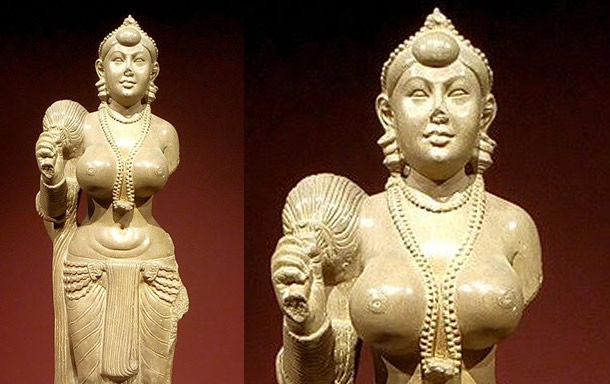
In several Asian cultures, including that of Tibet, beads made of stone called the ‘Dzi beads’ are prized as protective amulets. When somebody is in the need of healing, these beads are grounded into a powder and used as traditional medicines. Right at home, In India, beads have played an important role in forming a relationship with the divine – the followers of Shiva revere beads made of rudraksha seeds as they sing his praises, while those devoted to Vishnu, chant his prayers with tulsi seed beads.
Africa, with a history of beads going back 75,000 years, has still not given up on this traditional craft. The Zulu women of South Africa have been able to build a thriving industry with this craft. To express their love, the Zulu women handcraft beaded ornaments for their lovers. Each bead represents a different emotion; some colours, like red are a symbol of love or anger, while some beads are meant to represent heartache and loss. These beads are symbols of love, crafted with love.
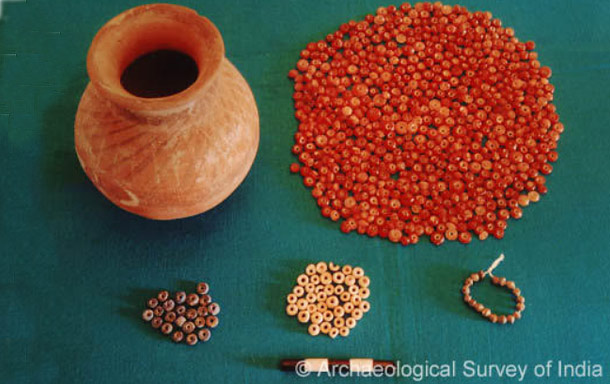
Till date, beads play a defining role in jewellery and fashion industry. Folks drawn towards ‘bohemian’ fashion, decorate their unconventional attires with beaded jewellery.
All these stories of inventions and exchanges over thousands of years talk of our connected history as humanity…. And the thread this time is a Tiny bead. A simple object that has seen us since the beginning of our existence when placed in its context, reflects at us our own story through the lens of art, trade, creativity, culture, trends and beliefs…. A story of brilliant complexities within simplicity !
Written By ~ Eric Chopra










